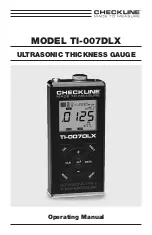
–12 –
3.5 Temperature
Temperature has an effect on sound velocity. The higher the temperature, the slower
sound travels in a material. High temperatures can also damage transducers and present
a problem for various liquid couplants.
Since the sound velocity varies with temperature it is important to calibrate at the same
temperature as the material being measured.
Normal temperature range
Most standard transducers will operate from 0°F to 150°F.
High temperature measurements
Special transducers and couplants are available for temperatures above 150°F with
intermittent contact. It is necessary to cool the transducer by submerging it in water
between measurements.
Modes and temperature errors
In addition to errors caused by velocity changing with temperature, some modes
(measurement techniques) are affected more than others. However, multi-echo
techniques offer temperature compensation help to minimize these errors.
3.6 Measurement Modes
This section will cover the different measurements modes of the TI-007DLX , the
transducers required, and the reasons for using specific modes:
Pulse-Echo (P-E) Mode:
Pulse-echo mode measures from the initial pulse (sometimes referred to as an artificial
zero) to the first echo (reflection). In this mode, a manual zero using the disk (battery
cover) will need to be performed prior to calibrating the TI-007DLX. The transducer
is placed on the reference disk located on top of the TI-007DLX, and the PRB 0 key
pressed to establish a zero point for the transducer connected.
Echo-Echo (E-E) Mode through Paint:
The echo-echo mode measures between the first and second return echoes/reflections.
This mode is most commonly used with the high frequency delay line style transducers
for thin materials, and will also eliminate compensate for temperature. This technique
will also eliminate error due to epoxy based coated surfaces by eliminating the error
from the coating and measuring only the second layer or base material without having to
remove the coating. The disadvantage is temperature. This technique will also eliminate
error due to epoxy based coated surfaces by eliminating the error from the coating and
measuring only the secondlayer or base material without having to remove the coating.
The disadvantage is that two return echoes are required to effectively measure the test
Содержание TI-007DLX
Страница 1: ...MODEL TI 007DLX ULTRASONIC THICKNESS GAUGE Operating Manual ...
Страница 44: ... 43 NOTES ...
Страница 45: ... 44 NOTES ...
Страница 46: ......














































